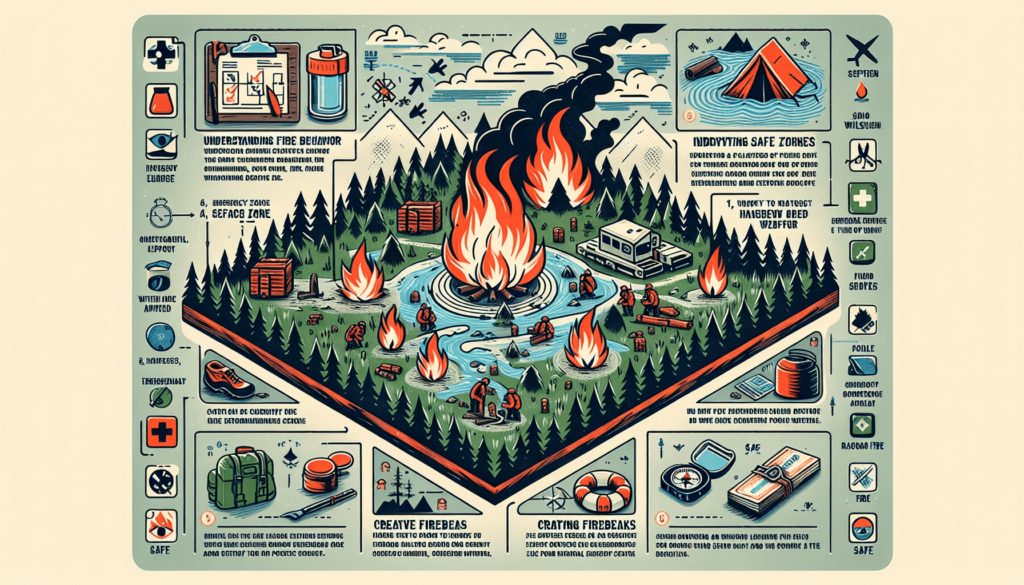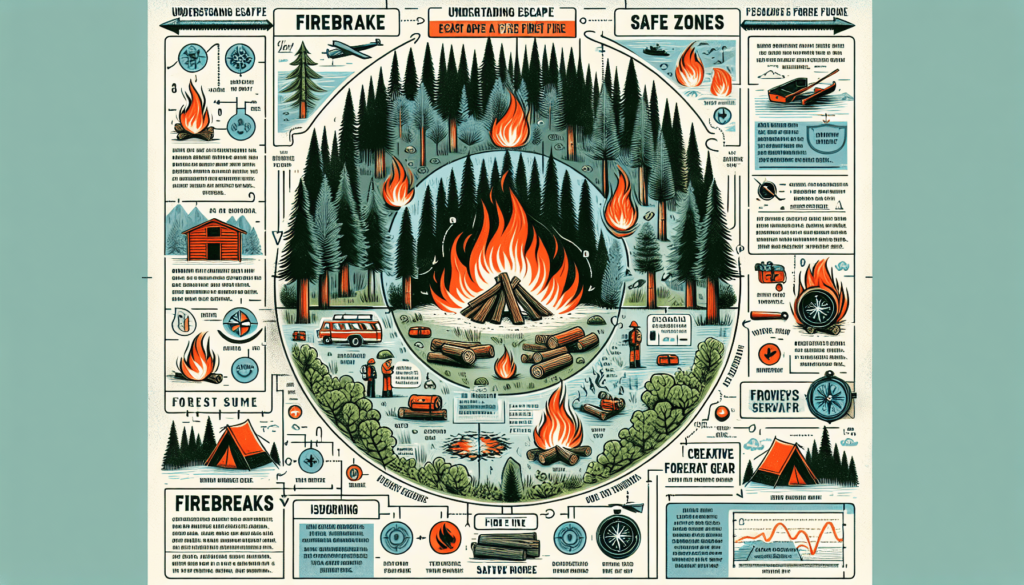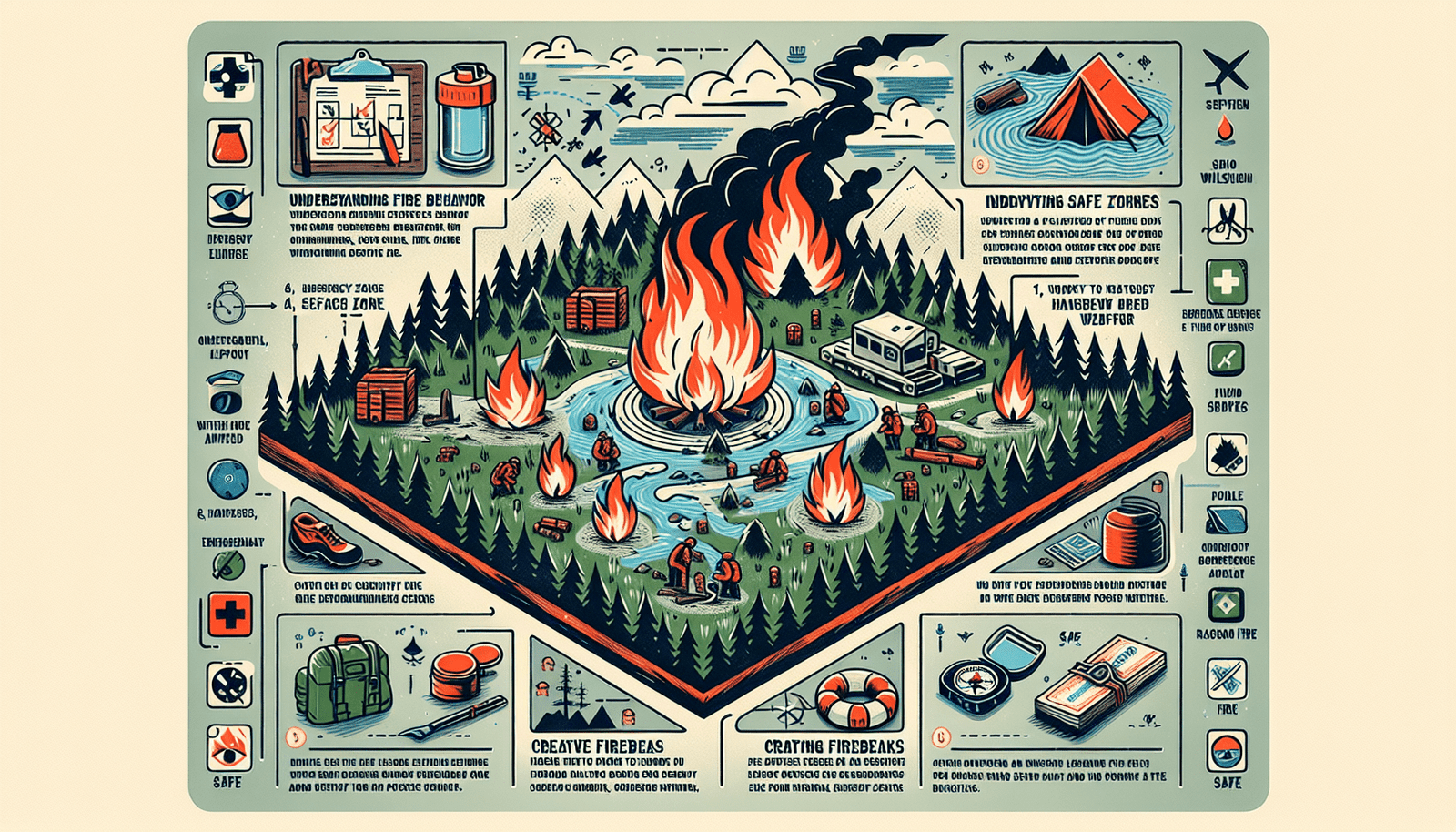Imagine you’re deep in the heart of a lush, untamed forest, surrounded by the beauty and tranquility of nature. But suddenly, chaos erupts as flames consume the trees and the air becomes thick with smoke. Panic sets in, but don’t fret, my friend. In this article, we’ll explore the art of survival in the face of a forest fire. From understanding the behavior of these ferocious infernos to learning the crucial tactics of escape and evasion, we’ll equip you with the knowledge and skills needed to outsmart and outlast even the most formidable of wildfires. So, grab your backpack, tighten your bootlaces, and let’s embark on this exhilarating journey into the wild unknown.

Understanding Forest Fires
Forest fires are a natural occurrence that can have devastating effects on both the environment and human lives. Understanding the causes, conditions, and behavior of forest fires is crucial for mitigating their impact.
Causes of Forest Fires
Forest fires can be caused by both natural and human factors. Natural causes include lightning strikes, volcanic eruptions, and spontaneous combustion. On the other hand, human causes of forest fires include campfires left unattended, discarded cigarettes, arson, and electrical equipment malfunctions. It’s important to exercise caution and follow fire safety guidelines to prevent such occurrences.
Conditions That Contribute to Forest Fires
Several conditions contribute to the spread and severity of forest fires. Dry weather, low humidity, strong winds, and high temperatures create favorable conditions for rapid fire growth. Additionally, the presence of dry vegetation, such as fallen leaves and dead trees, provides fuel for the fire. Understanding these conditions can help in predicting and preparing for forest fires.
Behavior of Forest Fires
Forest fires can exhibit different behaviors depending on various factors including the terrain, weather conditions, and the availability of fuel. They can spread quickly, creating intense heat and generating large amounts of smoke. Understanding fire behavior patterns, such as crown fires (spreading across the tops of trees) and ground fires (burning beneath the vegetation), is essential for making informed decisions during an emergency situation.
Preparation and Prevention
Taking proactive measures and being well-prepared can significantly reduce the risk and impact of forest fires. Here are essential steps to consider:
Creating a Fire-Resistant Campsite
When setting up camp, choose an area that is cleared of dry leaves, grass, and shrubs. Clear a perimeter around your campsite by removing any flammable debris. Use rocks or fire-resistant materials for a fire pit, and always keep a bucket of water nearby. Remember to extinguish the fire completely before leaving the site.
Building a Survival Kit
Having a well-equipped survival kit is crucial in situations like forest fires. Your kit should include essentials such as a first aid kit, emergency shelter, extra clothing, food, water, and a multipurpose tool. Additionally, include items like a waterproof map, compass, and flashlight with spare batteries.
Educating Yourself About Forest Fire Risks and Warnings
Stay informed about the specific risks and warnings associated with forest fires in your area. Familiarize yourself with fire danger rating systems and be aware of any signs indicating increasing fire risk. Follow the instructions of local authorities and pay close attention to evacuation alerts and orders.
Having an Evacuation Plan in Place
Create an evacuation plan that includes multiple escape routes and meeting points. Communicate this plan to all members of your group and ensure everyone understands the procedures. Regularly practice drills to ensure everyone knows what to do and where to go in case of a forest fire.
Recognizing the Signs of a Forest Fire
Being able to identify the signs of a forest fire is crucial for taking immediate action to protect yourself and others. Pay attention to the following indicators:
Smoke Detection and Assessment
Keep a lookout for the presence of smoke in the distance. Smoke color, density, and direction can provide valuable information about the proximity and severity of a forest fire. White smoke usually indicates a smaller fire, while dark or black smoke may signal a larger, more intense fire.
Observing Changes in Air Quality
If you notice a sudden decrease in air quality, with a strong smell of smoke and visible haze, it could indicate the presence of a nearby forest fire. Take this as a warning sign to be prepared to evacuate.
Identifying Signs of Heat and Fast-Spreading Fire
Fires generate intense heat, which can be felt even from a distance. If you feel an increasing temperature or notice a rapidly spreading fire, it is time to take immediate action. Watch out for flying embers or the sound of crackling flames, indicating the fire is approaching.
Immediate Response
When confronted with an ongoing forest fire, it is essential to respond quickly and effectively. Here are steps to take as part of your immediate response:
Assessing Your Immediate Surroundings
Evaluate your surroundings for potential hazards and sources of protection. Look for open areas, natural barriers, or bodies of water that may provide temporary protection from the fire. Stay away from steep slopes, canyons, and narrow valleys that can funnel flames and intensify fire behavior.
Determining the Direction and Speed of the Fire
Observe the direction in which the fire is moving and its speed. Be aware that fire behavior can change rapidly due to factors such as wind direction and the availability of fuel. This information is crucial for making informed decisions during evacuation.
Deciding on the Best Evacuation Route
Choose the evacuation route that leads away from the fire and has a lower risk of obstruction. Consider factors like terrain, road conditions, and potential traffic congestion. Having multiple routes in mind can provide flexibility in case one becomes inaccessible.
Considering the Terrain and Potential Barriers
Take into account the surrounding terrain and potential barriers that may impede your escape. Steep slopes, dense vegetation, and bodies of water can pose challenges. Adjust your route accordingly to maximize safety and minimize exposure to the fire.

Escape Techniques
When fleeing from a forest fire, it is essential to utilize various techniques to navigate the wilderness effectively:
Using Trails and Roads
Whenever possible, use established trails and roads as they tend to be safer and provide quicker access to safety. Stick to open areas and avoid vegetation that can be easily ignited. Remember to stay alert and watch for any falling debris or collapsing trees caused by the fire.
Navigating Through Dense Vegetation
If you find yourself surrounded by dense vegetation, stay low to the ground where the air is cooler and less likely to carry flames. Use a machete or other cutting tool to clear a path, but be cautious to avoid creating sparks that could start new fires. Move quickly but carefully to avoid tripping or getting lost.
Crossing Bodies of Water
When faced with a body of water, such as a river or lake, consider it a potential barrier to the fire. Cross the water if it is safe to do so, and find a safe location on the other side. If needed, use a flotation device or any available materials to aid in crossing.
Utilizing Natural Features for Cover
In some cases, natural features such as caves, rock formations, or depressions in the terrain can provide temporary shelter from a forest fire. Seek out these features and position yourself in a way that minimizes exposure to heat and smoke. However, be cautious of potential hazards like falling rocks or collapsed structures.
Emergency Shelters
In situations where immediate evacuation is not possible, finding or creating a suitable emergency shelter is crucial for survival:
Selecting a Suitable Shelter Location
When selecting an emergency shelter, prioritize locations that are away from potential fuel sources, high heat, and dense smoke. Look for clearings, rocky areas, or natural depressions that provide a degree of protection.
Building a Makeshift Shelter
If you have basic tools and materials available, construct a simple makeshift shelter using branches, leaves, and other natural materials. Make sure the shelter is well-insulated and provides enough space for you to lie down comfortably.
Improvising with Available Materials
If you don’t have the means to build a makeshift shelter, improvise with available materials like fallen trees, large rocks, or even the trunk of a car. Position yourself in a way that maximizes protection from the fire while allowing for adequate airflow to avoid smoke inhalation.
Using Natural Caves and Rock Formations
If you come across a natural cave or rock formation that provides shelter, consider taking refuge inside. Ensure that the area is safe from potential collapse or rocks dislodging from above. Use caution and be prepared to evacuate if necessary.
Protective Clothing and Equipment
Having the right clothing and equipment can greatly increase your chances of surviving a forest fire:
Choosing Fire-Resistant Clothing
wear clothing made of fire-resistant materials such as treated cotton or synthetic fabrics like nylon or polyester. Avoid wearing loose-fitting clothes that can easily catch fire and consider covering exposed skin with long sleeves and pants.
Wearing Suitable Footwear
Choose footwear that provides protection from both heat and sharp objects. Sturdy boots with thick soles are recommended to reduce the risk of burns and injuries. Avoid wearing open-toed shoes or sandals that leave your feet vulnerable.
Utilizing Breathing Masks and Goggles
Protect your respiratory system by wearing a mask designed to filter out smoke and fine particles. Additionally, goggles or safety glasses can shield your eyes from heat, smoke, and flying debris. Breathing masks and goggles should be easily accessible in your survival kit.
Carrying Fire Extinguishing Tools
Include fire extinguishing tools such as a fire blanket or fire extinguisher in your survival kit. These can be useful for controlling small fires or creating a barrier between yourself and an approaching fire. Remember to familiarize yourself with the proper use of these tools before an emergency arises.
Navigating in Smoky Conditions
When faced with smoky conditions, maintaining your orientation and avoiding disorientation is crucial for survival:
Using Compass and Map
If visibility is limited due to smoke, rely on a compass and map to navigate your way to safety. Keep a compass handy and practice using it before an emergency situation. Continually update your knowledge of the area’s topography to aid in navigation.
Non-Traditional Navigation Techniques
In extreme cases where traditional navigation methods are not feasible, consider non-traditional techniques such as using the sun’s position for direction or utilizing landmarks visible through the smoke. These techniques may require a basic understanding of celestial navigation or prior knowledge of the surrounding area.
Orienting Yourself Using Landmarks
If you can still discern landmarks through the smoke, use them as reference points to maintain your orientation. Look for prominent features like mountains, rivers, or distinct trees that can guide you in the right direction. However, be cautious of any changes in fire behavior that may alter your chosen path.
Survival Strategies
In addition to evacuating and finding shelter, employing various survival strategies can help increase your chances of staying safe during a forest fire:
Finding Clean Water Sources
Locate clean water sources such as rivers, streams, or lakes to ensure a continuous supply of drinking water. Use purification methods like boiling, chemical tablets, or a portable water filter to make the water safe for consumption.
Foraging for Edible Plants and Insects
In a survival situation, finding food can be challenging. Learn to identify edible plants, berries, nuts, and insects that may be available in the area. Remember to avoid any suspicious-looking plants or insects and only consume those you are confident are safe.
Identifying Safe Areas for Rest
Resting is essential to conserve energy and maintain mental and physical well-being. Look for areas away from the fire, free of potential falling debris, and sheltered from wind, if possible. Keep in mind that rest stops should be temporary and not replace the goal of finding safety.
Rescue and Recovery
If you find yourself in a dire situation during a forest fire, taking appropriate steps for rescue and recovery is vital:
Signaling for Help
Make yourself visible to potential rescuers by using signaling devices such as a whistle, mirror, or flashlight. Create loud, distinct noises in regular patterns to attract attention. Use any available materials to construct an eye-catching signal, such as a flag or marker.
Building a Signaling Fire
If you have the means to do so safely, build a signaling fire. Use dry, readily flammable materials like leaves, branches, or paper to create a visible plume of smoke. Ensure the fire is under control and monitored to prevent it from spreading.
Creating Visible Markers
Leave visible markers along your path to indicate your direction of travel. Use brightly colored materials like clothing, ribbons, or reflective tape tied to trees or placed on the ground. These markers can assist search and rescue teams in locating you.
Following Search and Rescue Protocols
Stay calm and follow any instructions provided by search and rescue teams. Cooperate fully, providing accurate information about your situation and any injuries sustained. Remember to prioritize your own safety and well-being during the rescue process.
Surviving a forest fire requires a combination of preparedness, knowledge, and quick thinking. By understanding the causes, conditions, and behavior of forest fires, creating a fire-resistant campsite, and knowing how to respond in an emergency, you can increase your chances of staying safe and surviving. Take the time to educate yourself, practice necessary skills, and be prepared for any potential wildfire scenarios. Stay safe and enjoy your wilderness adventures responsibly!

